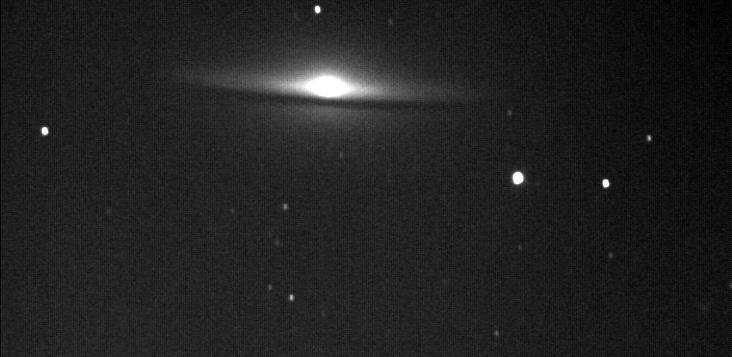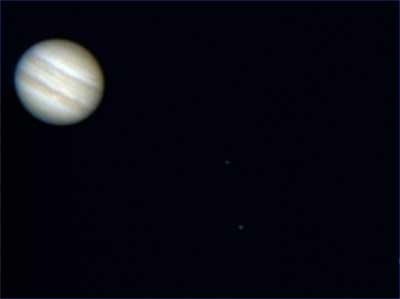Tom Coombs on Astronomy
Our telescopes now number 2. The original Meade ETX-125PE and also now a Celestron C10-N GT, you can read more about these on the equipment page (which I have yet to create), however I have put brief reviews of each up at ePinions.com. The ETX-125PE review and the C10-N GT review.
This is the "Clear Sky" clock for West Palm Beach, FL"

4.19.06: Astrophotography at home
I just recieved a package in the mail that contained an Orion StarShoot CCD camera. This little camera is designed to fit into the telescope and capture long exposure images. Also in this package was a Celestron NexImage webcam CCD. I took the both out last night and captured these pictures.
|
|
Jupiter and moons
Here you can see Jupiter with a pair of moons visile to the lower right. Without knowing it I have actually captured the great red spot and red jr. (lower center) of the planet.
This was taken with the NexImage WebCam
|
|
|
Saturn
Taken with the NexImage and showing some planetary detail and also the Cassini division in the rings.
If you look carefully at the bottom of the planet you can see the dark polar area.
|
 |
M104 - "Sombrero Galaxy"
Taken with the StarShoot. This is a stacked image made up from 32 frames, each 20 seconds long in exposure. Anything longer than that and I start to see star trails from errors in the mount.
This galaxy is around 28 million light years from earth as is approximatley 50 thousand light years across.
|
3.18.06: Jonathon Dickenson State Park, Jupiter, FL
One of the closes kinda-dark sky sites is the local state park, each month the local astronomy club meet there for a pleasant evenings observation.
A very pleasant evening with lots of targets sighted and identified. The skys were transparent and steady.
You can see my telescope here, with a 9.25" Celestron SCT in the mid-ground and a 5" Celestron in the background. Everyone is set up ready for polar alignment when it got dark.

3.9.06: With the kids at Home, Lake Worth, FL
Spent the evening outside tonight looking at the moon with the kids. Took out the ETX and had them looking at craters and valleys and things like that. They were enthralled for about 30 minutes which for a 5 year old and a 2 year old is pretty good. It also gave me a chance to try out the new Orion Stratus Eyepieces.
2.26.06: Fisheating Creek, Palmdale, FL (26 56 36.9N, 81 19 07W)
We just took a trip to Fisheating Creek, over near Palmdale, FL. Don't worry if you have never heard of it, you really don't want to know about it unless you live there. But it is one of the few places in the South Eastern United States where you can get a truly dark sky. The trip was almost a bust, with a fairly grotty weather forecast, so I took along my son and we camped from Friday through to Sunday. We had a lot of fun and by chance, Saturday night was clear and wow, were the stars bright.
I had a few equipment problems that turned out to be finger trouble, I had keyed in the wrong location and also selected the wrong date. These were quickly found and resolved however.
Saturn (one of my all time favorites) was clear and bright, with the rings showing off all of their divisions/shadows without hesitation. The planet presented lots of detail and all of this at higher magnifications (x380).
I moved on a viewed the double cluster, Pleiades, mars (not much to see there, but I keep trying). Andromeda and M110 were too low in the sky to observe (because of a camp fire) and I had issues finding M81/M82.
After a number of other targets, and being discovered by the local camp populous, with the obligatory "what are you looking at?" "how do...?" "How much did this cost?" questions and my favorite "Perhaps he'll point it at Uranus honey...{chortle chortle}" jokes and also that fact that a good number had partaken of some tasty malt beverages, I decided to call it quits at around midnight.
I am still amazed whenever I go somewhere really dark, the number of stars and the grandeur of the night sky takes my breath away every time.
Here is a picture I took of Mars with the Seven Sisters (Pleiades/M45)...

This is actually a series of 12 pictures, each of 60 seconds exposure time, that were then stacked and merged, that we all of the smaller dimmer stars show also, as you can see there really are rather a lot of stars in there. The bright orange ball on the left is the planet Mars.
This is the "Light Pollution" drawing for South Florida
Astronomical Links:
Suppliers:
(C) Copyright 2006, Coombs-Online.NET



